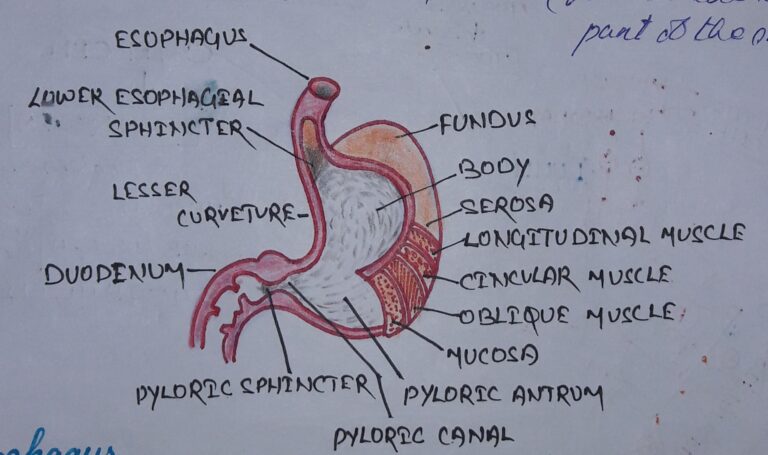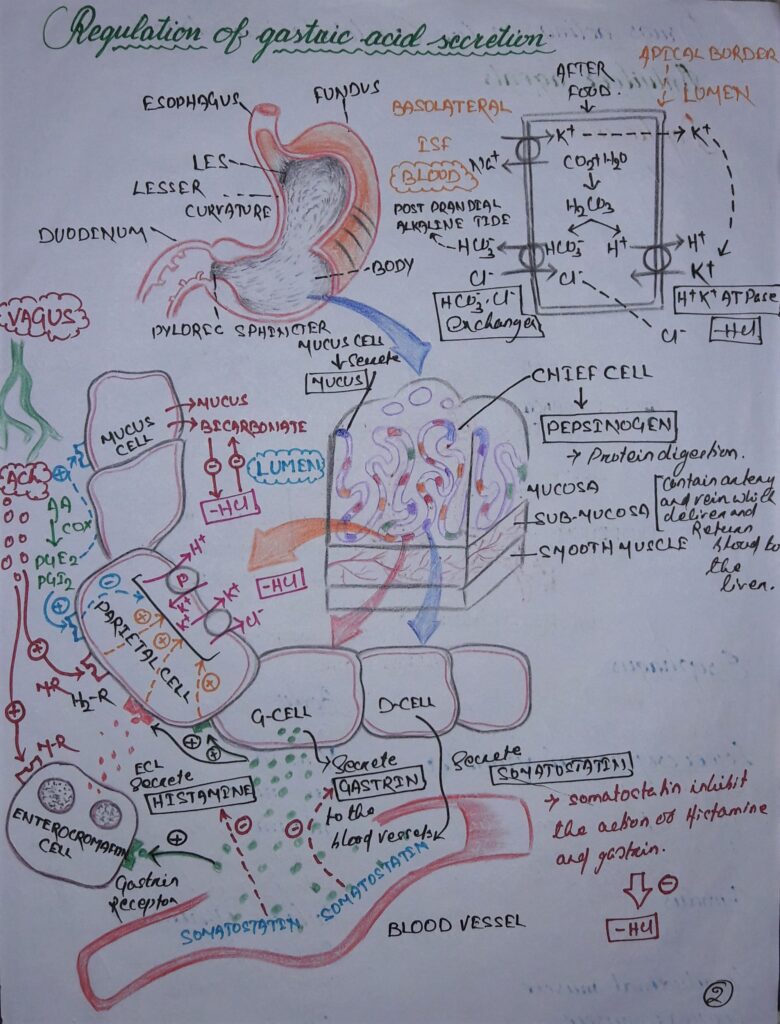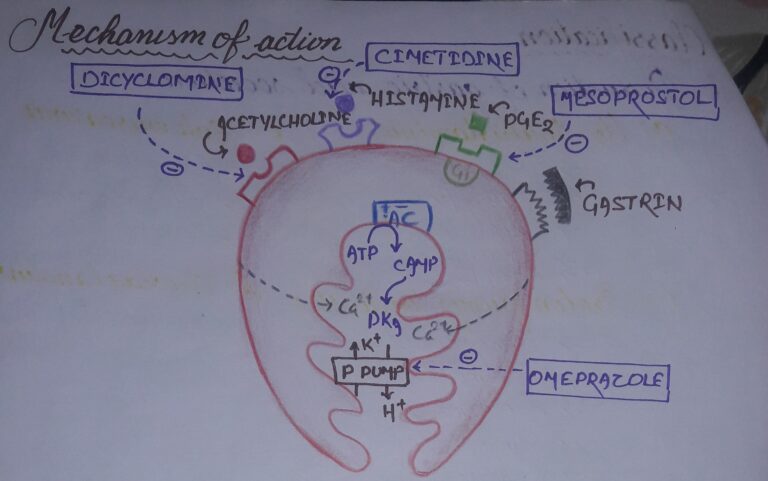PEPTIC ULCER
· Peptic ulcer is gastrointestinal disorder which is exposed to gastric acid and pepsin on the lining of the esophagus, stomach and small intestine.
· There are two type of peptic ulcer
1. Gastric ulcer (lining of the stomach)
2. Duodenal ulcer (from in the upper part of the small intestine)
PARTS OF THE STOMACH
Esophagus
· It is a muscular tube links the throat to the stomach.
Lower esophageal sphincter
· LES open to allow the food particle to the stomach and then closes quickly to prevent back into the esophagus.
Fundus
· Stores gases produce during digestion.
Longitudinal muscle
Circular muscle
Oblique muscle
Body
· Volume is 50 ml when empty, then expand up to 1 liter.
Mucosa
Submucosa
· Contain arteries and vein which delivered and return blood to the liver
Antrum
· It produces chyme
· Strong wave like muscle (strong peristaltic contraction).
Pyloric sphincter
· The chyme is pushed depends upon the strength of the peristaltic contraction.
Duodenum
· The chyme is mixed with digestive enzyme and bile in the duodenum.
· Contains 25-38 cm (small intestine), where nutrients absorption begins.

PHASES OF GASTRIC ACID SECRETION
1. Cephalic phase
· Cephalic phase is activated by the thought, taste, smell and sight of food, and swallowing, mediated mostly by cholinergic/vagal mechanisms.
2. Gastric phase
· Gastric phase is due to the chemical effects of food and distension of the stomach
3. Intestinal phase
· Intestinal phase only a small proportion of the acid secretory response to a meal; its mediators remain unknown.
REGULATION OF GASTRIC ACID SECRETION
· Histamine, Ach and Gastrin have their own receptors located on the basolateral membrane.
· The primary action is that to secrete H+ ion in the apical canaliculi of parietal cell through the enzyme H+ K+ ATPase.
· Gastrin and Ach act partly directly and to a greater extent indirectly by releasing histamine from paracrine enterochromaffin-like (ECL) cells called “histaminocytes” located in the oxyntic glands.
· While H2 receptors activate H+ K+ ATPase by generating cAMP, muscarinic and gastrin/cholecystokinin (CCK2) receptors through the phospholipase C (IP3–DAG) pathway that mobilizes intracellular Ca2+.
· Prostaglandins have a “cytoprotective” role in the gastric mucosa by secreting mucus and bicarbonate.
· Somatostatin blocks the action of histamine, Gastrin and also the HCl production.

CLASSIFICATION
1) Reduction of gastric acid secretion
(a) H2 antihistamines:
· Cimetidine
· Ranitidine
· Famotidine
· Roxatidine
(b) Proton pump inhibitors:
· Omeprazole
· Esomeprazole
· Lansoprazole
· Pantoprazole
· Rabeprazole
· Dexrabeprazole
(c) Anticholinergic drugs:
· Pirenzepine
· Propantheline
· Oxyphenonium
(d) Prostaglandin analogue:
· Misoprostol
2) Neutralization of gastric acid (Antacids)
(a) Systemic:
· Sodium bicarbonate
· Sod. citrate
(b) Non-systemic:
· Magnesium hydroxide
· Mag. Trisilicate
· Aluminium hydroxide gel
· Magaldrate
· Calcium carbonate
3) Ulcer protectives:
· Sucralfate
· Colloidal bismuth subcitrate (CBS)
4) Anti-H. pylori drugs:
· Amoxicillin
· Clarithromycin
· Metronidazole
· Tinidazole
· Tetracycline
MECHANISM OF ACTION
· Gastric acid secretion is stimulated by Ach, Histamine and Gastrin, which activate protein kinase (PKA) turn stimulates H+ K+ ATPase (proton pump).
· Dicyclomine and Cimetidine binds to the cholinergic and histamine receptor to inhibit the activation of adenylyl cyclase.
· Omeprazole inactive the proton pump.
· Prostaglandin shows inhibitory action to produce inactive the adenylyl cyclase. This action is blocked by Mesoprostol.

REDUCTION OF GASTRIC ACID SECRETION | |||
H2 Anti-histaminic | Proton pump | Anti-muscarinic | Prostaglandin |
· Act selectively on H2 receptor. · They are competitive antagonist (Reversible). Cimetidine · Prodrug · Inhibit CYP450 · Produce endocrine effect like Gynecomastia and galactorrhea (anti-androgenic effect). Ranitidine & Famotidine · No anti-androgenic effect. Nizatidine · ↑more bioavailability ADME · Widely distributed throughout the body (including breast milk and across the placenta). · Excreted in urine. · Available in i.v. formulation. THERAPEUTIC USES · Peptic ulcer · GERD · Zollinger Ellison syndrome (ZES) | · Inhibit H+ K+ ATPase (proton pump) · Inhibit irreversibly · It has enteric coated that absorbed in small intestine and diffuse to the blood then it diffuses back to the parietal cell. ADME · Effective orally · Food interaction ↓se absorption. · Administration 30 min before food. · Highly plasma bound · Available in parenteral. ADR · ↓se vit. B12 absorption. · Gastric tumor · Hyperprolactinemia · Inhibit CYP2C19 (inhibit effectiveness of clopidogrel). · Hypomagnesemia THERAPEUTIC USES · DOC → GERD · Peptic ulcer · Used with antimicrobials to treat H. pylori. | · Selective for M1 receptor. · Not usually used because ↓se efficacy and shows serious side effects. | · ↓se gastric acid secretion. · ↑ secretion of mucus. · ↑ bicarbonate · ↑ HCO3– these effect shows the cytoprotective effect. CONTRAINDICATIONS · During pregnancy produce uterine contraction and abortion. |
Ulcer Protective | Acid Neutralizing Agents | Anti-H. Pylori Agent | |
Non-Systemic | Systemic | ||
· Sucralfate in acidic medium get polymerized and stick on the ulcer area. · Also, protein ppt at the site of the damage. · ↑PGs · ↑Mucus · Epidermal growth factor · ↑ HCO3– secretion · Taken one hour before meal · It needs acidic pH to work so, Antacid, PPIs should not give along with this. · Used in GERD | · Magnesium hydroxide, Aluminium salts, magnesium salts, calcium carbonate reacts with HCl to form salts. SIDE EFFECTS · Constipation · Diarrhoea · Hypercalcemia | · Sodium bicarbonate and sodium citrate · Having short acting and rapid absorption. · Release CO2 · Produce alkalosis · Rebound acidity AVOID · BP ↑se, CHF due to retention of Na+.
| · Urea ↓ H. Pylori CO2 + NH3 · CO2 is dissolved in the blood and transported to the lungs. · Exhaled CO2 is analyzed the presence of H. Pylori results in an ↑se in the ratio of CO2. Triple therapy 1. PPIs 2. Amoxicillin (Mtz may be used in penicillin-allergic patients.) 3. Clarithromycin Quadruple therapy 1. CBS 2. Metronidazole 3. Tetracycline 4. PPIs |

Hi….!! My name is Smrutiranjan Dash, From Odisha, India. Professionally I am Assistant Professor at The Pharmaceutical College, Barpali, Odisha, department of Pharmacology.
